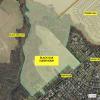Shutdown stalling striped bass management decisions
For months now I’ve heard there are plenty of striped bass out in the ocean - about seven miles out.
“They’re out there and they’ll bite, but that’s in federal waters where it’s illegal to take or target striped bass. And the feds are enforcing with drones. No sense in risking it.”
I heard that on a number of occasions.
At the same time, the consensus has been that very few keeper-sized stripers were around for the late fall and early winter season this year in coastal waters inside the three-mile line. Way off from previous years in the past 20 when we counted on a decent late striper season in those waters.
In the 1990s, there was a moratorium on all striper harvest due to concerns that the overall population of this popular East Coast fishery had fallen to unsustainable levels. With that moratorium, striper numbers gradually started to rebound. Limited harvest levels eventually returned with the lifting of the moratorium in coastal waters, and there was a sense that a solid recovery was underway.
I started wondering why the moratorium is still in place for the federally controlled waters of the Atlantic - also known as the Exclusive Economic Zone - which extends from three miles off the coast out to the 200-mile line. There are plenty of people who would like to get out there where the fish have apparently decided to migrate.
I’m not the only person thinking that way. Roy Miller, who lives in Lewes, is one of three Delaware representatives on the Atlantic States Marine Fisheries Commission for Delaware. He is a fisheries biologist by training and served as administrator for the fisheries section of Delaware’s Division of Fish and Wildlife for many years. The commission meets periodically to review fishery stocks in coastal waters and make management recommendations - harvest seasons, sizes and catch quotas for recreational and commercial fishermen - in an attempt to keep populations healthy and sustainable.
“They [the stripers] bypassed us apparently this year,” said Miller. ”Stayed outside our state waters. Now we’re all waiting to see the results of the overall stock assessment that was completed in November.” Miller said he hasn’t seen the results which were scheduled to be presented to members of the council at their February meeting. “But there are rumors out there that we may be in a condition of overfishing and that could change our management approach. That concerns those of us who sport fish and commercially fish for striped bass. The council might end up tightening limits or sizes or length of season.”
John Clark is current fisheries administrator for Delaware’s Division of Fish and Wildlife and also a member of the ASMFC. He said striped bass management is another area being affected by the partial government shutdown. “The survey results should have been released by now, but the shutdown has halted the review process, so I don’t know how much talk there will even be about striped bass at that meeting in the first week of February if we don’t get survey information.”
He was in agreement with Miller about the rumors. “What we’re hearing is that the numbers aren’t indicating the kind of recovery in the fishery we would like to see.”
It was hoped that a 25 percent reduction in the permitted overall take by recreational and commercial fishermen instituted in 2015 would lead to more of a recovery than has been seen. He noted that Delaware’s commercial fishermen have no trouble catching the permitted quota poundage for striped bass. “From a monetary point of view, they’re our most valuable species,” he said.
Easing offshore restrictions?
Miller agreed that striped bass have not come inshore or lingered off Delaware for the past few years when they were migrating south for the colder months. “There had been some talk of a potential lessening of the fishing restrictions out in the EEZ. That area hasn’t been opened for years. But some see it as a conservation zone because that’s where the larger fish - the breeders - seem to be.”
Still, Miller saw the lessening of restrictions in offshore waters as a potential agenda item for the February meeting.
“There were lots of smaller fish around this summer. They were thick at times in the Lewes-Rehoboth Canal. Fish in the 12-inch to 20-inch size. And in Indian River Inlet. But for the larger fish, there has been a downward trend for several years.”
He said that downward trend could lead to more restrictions for recreational fishermen, such as raising the size limit or reducing the permitted harvest to one fish per day. The limit for several years has been two fish per day, but with certain conditions.
The conditions give a sense of how precisely Delaware’s fisheries managers work to meet federal guidelines for total permissible take. The season for striped bass is open all year, but on the state’s striped bass spawning grounds, the fishery is all catch-and-release between April 1 and May 31. Delaware’s designated striped bass spawning grounds include Nanticoke River, C&D Canal, and Delaware River north of and including the south jetty at the mouth of C&D Canal, or any tributaries of these waterways.
The fish allowed to be taken other than in the spawning season have to be between 28 and 37 inches or greater than 44 inches. That’s to give greater protection for spawning-age females.
Additionally, in July and August, anglers fishing in Delaware Bay and River and their tributaries - such as Broadkill River - can also keep fish between 20 and 25 inches. Clark said Delaware’s managers were able to argue effectively for that particular smaller slot in those waters by proving that most of those fish are male stripers and part of a resident population.
Federal managers have set a threshold for what they consider to be the least amount of spawning striped bass in their entire East Coast territorial waters - measured in metric tons - that will keep the fishery sustainable.
The fishery has been managed since 1984 when the Atlantic Striped Bass Conservation Act was passed by the United States Congress.
If the stock assessment is presented at the February meeting and comes in at below that threshold, there will be pressure to do at least one of two things. Those who think the threshold set by the managers and scientists is too high could lobby to have the number reduced to forestall further restrictions.
The other possibility is what Miller mentioned: further restrictions to reduce fishing pressure to allow the fishery to climb back to what is presently considered sustainable.
There will be controversy either way, but in the long run, the sustainable health of the striped bass fishery has to come first.
















































